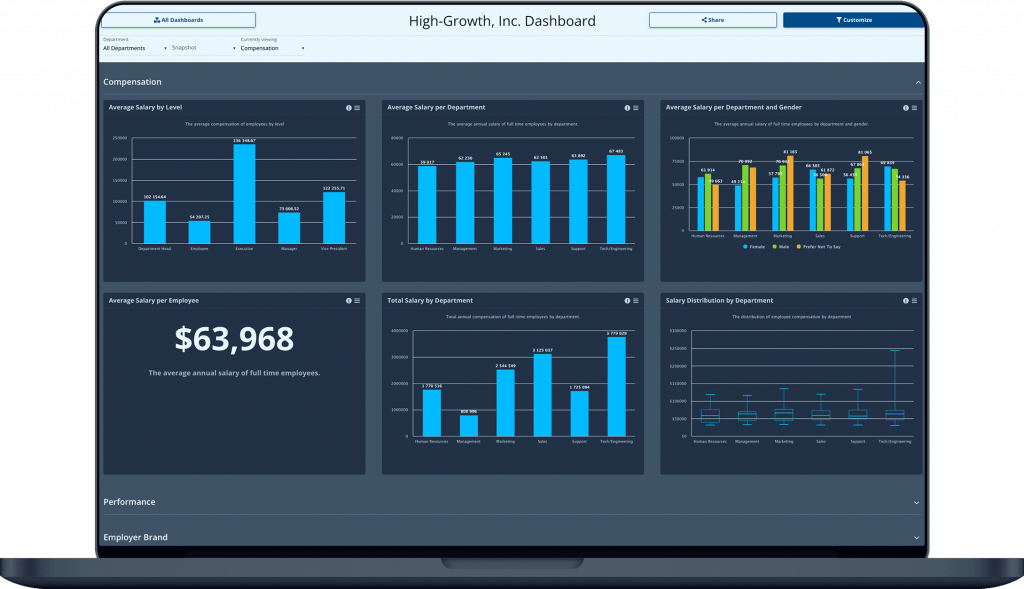When candidates consider a job offer, there’s typically more that they’re looking for than just salary and healthcare benefits. Once a job offer is received, candidates may look at typical work schedules, company culture, safety in the work environment, and in post-pandemic times may look at if remote work is still a possibility. That’s why thorough compensation plans are an effective tool for attracting the most skilled workforce. But what is exactly is a compensation plan and how should you create one? Let’s explore the answers below.
What is a Compensation Plan and why is it important?
A compensation plan, also known as a “total compensation plan,” itemizes the details of the compensatory components of a company’s strategy (i.e. employee’s salary or wages, bonus, raise schedules, long-term benefits, work schedule and paid time off, health insurance, miscellaneous benefits, and retirement plan). Your organization should use compensation plans to account for workflows, to save time, and to minimize costs. And your compensation plans need to be aligned with your organization’s budget limits. There will never be a one-type-fits-all compensation plan – they are almost always dependent upon the type of work, market conditions, availability of the required skill set, and workforce demands.
Compensation plans are effective tools for attracting and retaining the most skilled workforce. Large corporations include benefits like free lunch, childcare, play areas, and flexible schedules to create an environment where employees will work extended hours in the office. On the other hand, other organizations may offer a 4-day work week to boost productivity in 4, 10-hour days. This can compel employees to work harder for perks that are linked with higher productivity.
An effective compensation plan offers a balance of fair pay, bonus structures, generous benefits, and productivity awards, while also providing appropriate days off for rest and relaxation. It all really boils down to a good work/life balance.
The Society for Human Resource Management (SHRM) further outlines the purpose and value of maintaining a dynamic and strategic compensation plan:
- Describes how your company’s compensation philosophy supports your business strategy, industry competitiveness, operations objectives, and workforce needs
- Helps attract and retain qualified candidates to join your company
- Serves as a strong motivator for your employees to be high-performing and exceed their goals
- Keeps your business competitive in the marketplace with pay, incentives, and benefits
What are the Typical Components of a Compensation Plan?
Salary and Wages
Salary is a fixed regular payment, typically paid on a monthly or biweekly basis, but often offered as an annual sum by an employer to an employee. Wage is a fixed regular payment, typically paid on a daily or weekly basis, made by an employer to an employee. This area is the most important section of your compensation plan. And it’s typically the deciding factor of candidates considering joining your organization.
Bonus
Bonus is an amount of money added to wages on a seasonal basis, especially as a reward for good performance. This can be a great incentive to boost productivity within your organization. Bonuses can be offered as a lump sum payment or through profit sharing.
Long-Term Benefits
These are incentives that have an extended time horizon typically greater than 12 months and are used to promote retention and alignment with company goals. Within your organization, these incentives could be appreciation-based (on your company’s underlying value), stock-based (delivered in shares of company stock), or cash-based (for service levels, achievement of performance goals, or both).
Work Schedule and Paid Time Off
It’s important to provide details of days off allotted for sick leave, personal leave, and vacation time. Flexible work hours and different work schedules could also be good motivators for employees.
Health Insurance
Also known as medical insurance, this type of benefit covers the whole or part of the risk of an employee incurring medical expenses.
Miscellaneous Benefits
Some organizations offer club memberships, product discounts, company cars, travel discounts, housing and meal stipends, and more.
Retirement Plan
An employer sponsored retirement plan is where both an employer and an employee make contributions into an account each month. The contributions are invested on behalf of an employee, who may begin to make withdrawals after retirement. Retirement plans can include various types of benefits such as 401(k), stocks, bonds, mutual funds, EFTs, and more.
Deferred Compensation
This is an arrangement where a portion of an employee’s income is paid out later after the income was earned. Examples of deferred compensation include pensions, retirement plans, and employee stock options. The primary benefit of most deferred compensation is the deferral of tax to the date the employee receives the income.
The advantages of a deferred compensation plan include tax savings, the realization of capital gains, and pre-retirement payments. Additionally, this type of plan reduces income the year an employee puts money into the plan, then allows that money to grow without annual taxes being assessed on the invested earnings.
Compensation Planning 101: What Are Steps in Designing a Compensation Plan?
To properly design a compensation plan, it’s important to include these steps to help your organization stay competitive and attract the top skilled workforce you need:
- Research the job market. Ensure you understand competitive compensation and marketplace pay ranges for employees that will perform similar work, in the same region of the country, within similar industries.
- Define your company’s compensation philosophy. Your organization can choose to lead the market by offering higher compensation, lag behind the market with lower compensation than other companies or match the market by offering the same compensation as competitor companies.
- Decide whether you will implement salaries or hourly wages. Items that will influence your decision are the industry you are operating in, the size of your company, your company’s revenue, the job positions you are looking to fill, and the importance of these positions to ensure the success of your company.
- Identify the benefits you will offer. To attract top talent, it’s important to offer a competitive benefits package in addition to pay that includes health insurance, paid time off, paid holidays, pay raise schedules, flexible work schedules, and work breaks.
Why Compensation Planning is Necessary
To remain competitive with this ever-changing world, it’s critical to stay up to date with market changes and trends in all industries. Update your compensation plan on a regular basis to remain current. And remember to use resources available to you for market surveys and salary data from the National Compensation Survey (U.S. Bureau of Labor Statistics) and the Cost of Living Adjustment (COLA) (Social Security Administration).
No matter how big or small the compensation package is offered by your organization, what really matters is the vision to continue moving forward with a productive, motivated, compensated workforce that helps your organization achieve its goals and objectives. To better understand the value of your workforce and how they contribute to your organization during compensation planning, understanding HR metrics and data analytics will help you create the best compensation plan for your workforce. Have a look at an example compensation dashboard from Employee Cycle that your data-driven peers from companies like Axios and Agora are utilizing.

How much easier would it be for you to have all the relevant HR data you need from multiple systems at your fingertips in a single, unified data dashboard to help you create that compensation plan? Try Employee Cycle’s HR analytics data dashboard today and see how easy it is to unify your data systems into a single location today. Get started for free and create your account here.












